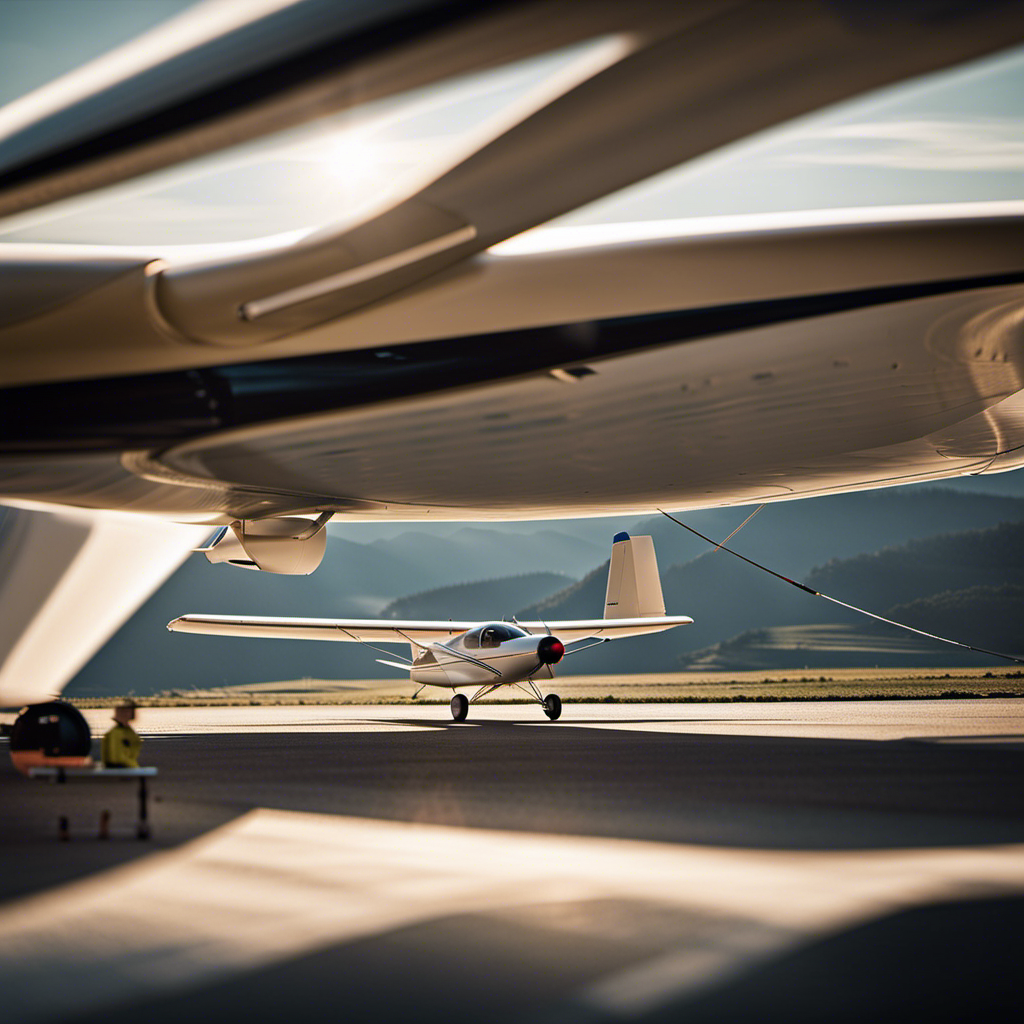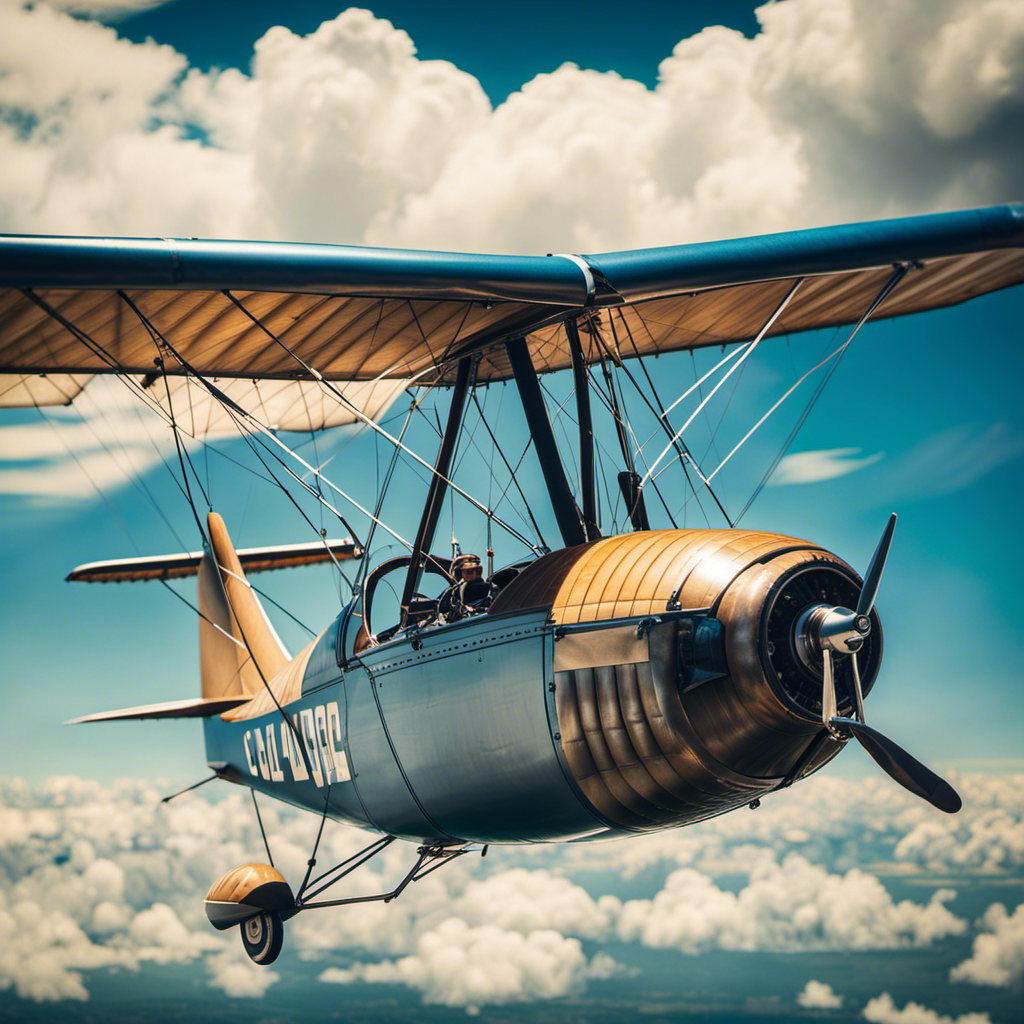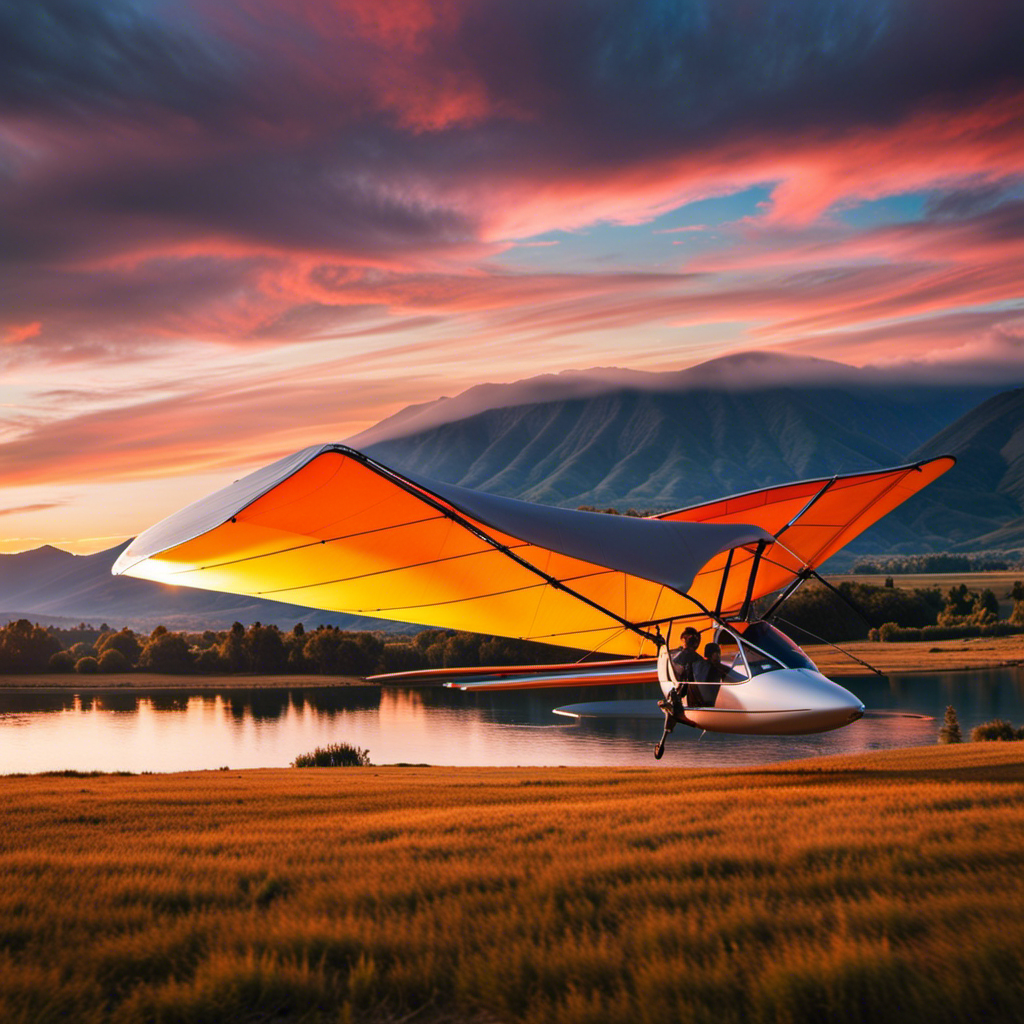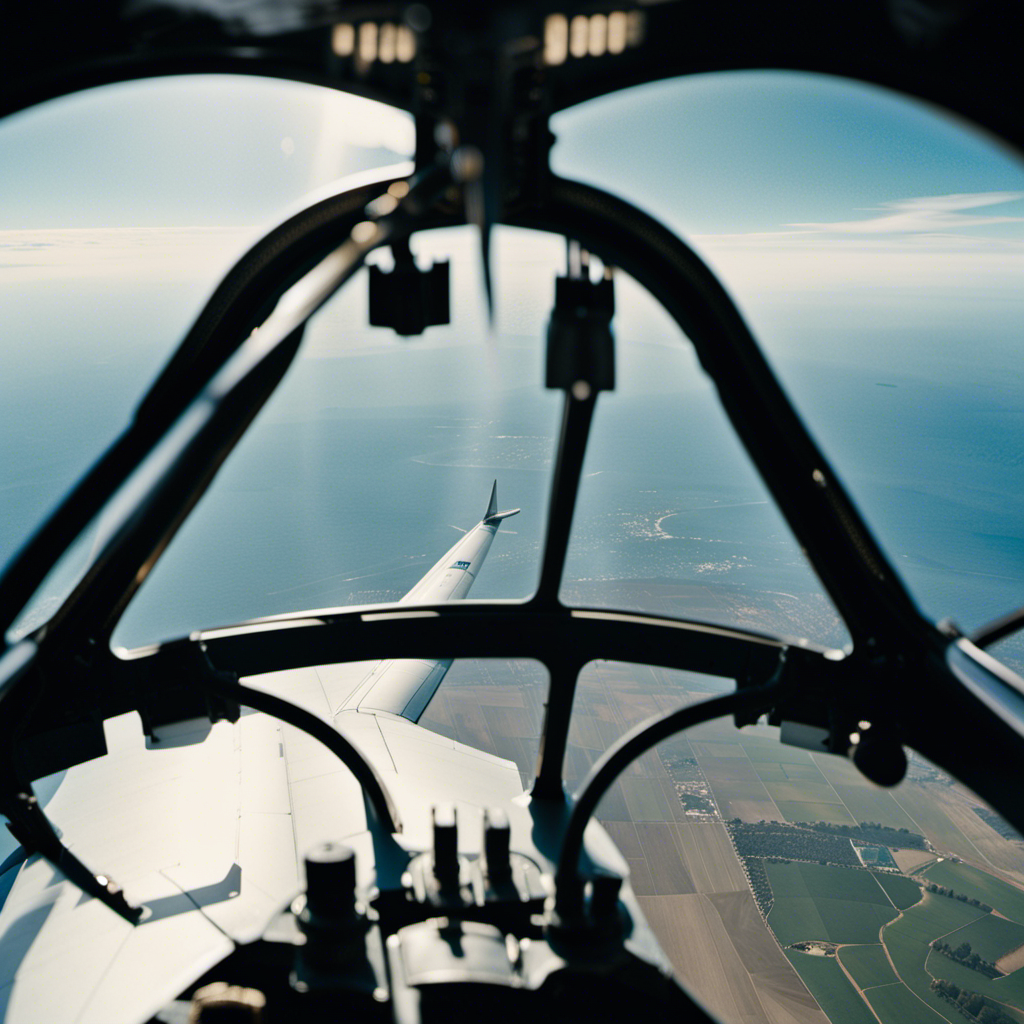Imagine soaring through the air, gliding effortlessly in a sailplane.
In this article, we will take you on an in-depth journey into the fascinating world of sailplanes and their intricate mechanisms. From the rich history of these aircraft to the understanding of aerodynamics, we will explore every detail.
Discover the various launching methods, master the art of soaring techniques, and learn about the safety measures in place.
Get ready to delve into the world of competitive gliding and marvel at the famous sailplane records and achievements.
Finally, we will glimpse into the future, exploring the exciting innovations in sailplane technology.
Get ready to be captivated by the wonder of sailplanes!
Key Takeaways
- Sailplanes have evolved over time thanks to advancements in materials and aerodynamics.
- Understanding aerodynamics is crucial for designing and flying sailplanes.
- Sailplanes can be launched using winch launching, aerotow launching, or self-launching methods.
- Self-launching options for sailplanes include electric, jet-assisted, and hybrid models.
The History of Sailplanes
You might be interested to know that the history of sailplanes dates back to the early 20th century.
The first glider flights were conducted by Otto Lilienthal in the late 19th century, but it was not until the early 20th century that true sailplanes were developed.
The early designs were simple, with wooden frames and fabric-covered wings. They relied on the natural forces of lift and gravity to stay aloft, without the need for an engine.
Over time, advancements in materials and aerodynamics allowed for the development of more efficient sailplanes.
Understanding aerodynamics is essential in designing and flying sailplanes. By studying the forces acting on the aircraft, such as lift, drag, and weight, pilots can manipulate their flight path and maximize their soaring potential.
Understanding Aerodynamics
To understand aerodynamics, it’s important to grasp how air flows around an aircraft’s wings. When a sailplane takes flight, the shape of its wings plays a crucial role in generating lift. The wings are designed with a curved upper surface and a flatter lower surface.
As the sailplane moves forward, the air splits, with some passing over the curved upper surface and some passing below the flatter lower surface. This creates a pressure difference, with lower pressure on the top and higher pressure on the bottom. The result is an upward force called lift, which allows the sailplane to stay airborne.
Now, let’s move on to the structure of sailplanes, which further enhances their performance and efficiency.
The Structure of Sailplanes
Now, let’s delve into how sailplanes are built, specifically focusing on their structure and how it enhances their performance and efficiency.
Sailplanes are meticulously designed to maximize their aerodynamic capabilities and ensure optimal flight characteristics. The structure of a sailplane is a crucial component in achieving this. It is typically constructed using lightweight materials such as carbon fiber, fiberglass, and foam, which provide strength while minimizing weight.
The wings are designed with a high aspect ratio, which means they are long and narrow, reducing drag and increasing lift. The fuselage is sleek and streamlined, further reducing drag. The tail section, including the horizontal stabilizer and vertical fin, helps with stability and control.
By carefully engineering the structure, sailplanes are able to achieve exceptional performance in terms of glide ratio, speed, and maneuverability.
Now, let’s move on to the next section and explore the various launching methods used for sailplanes.
Launching Methods
When it comes to launching sailplanes, there are three main methods to consider: winch launching, aerotow launching, and self-launching options.
Winch launching involves using a powerful winch to rapidly pull the sailplane into the air, allowing it to gain altitude and start soaring.
Aerotow launching involves being towed into the air by a powered aircraft, which then releases the sailplane at the desired altitude.
Lastly, self-launching options refer to sailplanes that have their own engines, allowing them to take off independently without the need for external assistance.
Each method has its own advantages and considerations, and understanding them is crucial for any sailplane pilot.
Winch launching
The winch launching method propels sailplanes into the air using a powerful cable system. Here’s how it works:
-
Sailplane preparation: Before the launch, you secure yourself in the cockpit and fasten your seatbelt and shoulder harness tightly. You check the control surfaces and the integrity of the glider to ensure everything is in working order.
-
Cable attachment: A steel cable, typically around 1,000 feet long, is attached to the sailplane’s nose. The cable is wound around a drum on the winch, ready to be rapidly unwound during the launch.
-
Winch operation: The winch, with its powerful engine, quickly unwinds the cable, generating a tremendous amount of force. The sailplane accelerates rapidly, gaining altitude as it is pulled into the air.
-
Release: Once the desired altitude is reached or the sailplane reaches the end of the cable, the pilot releases the cable, and the sailplane continues its flight independently.
Now, let’s explore another method of launching sailplanes: aerotow launching.
Aerotow launching
Now that you have a clear understanding of how sailplanes are launched using the winch method, let’s dive into another popular launching option: aerotow.
In this method, a powered aircraft tows the sailplane into the air using a long tow rope. The tow rope is attached to the nose of the sailplane, typically to a tow hook mounted on the fuselage. As the powered aircraft accelerates down the runway, it generates enough lift to lift both aircraft off the ground.
Once the desired altitude is reached, the tow rope is released, and the sailplane is free to continue its flight. Aerotow launching offers several advantages, including the ability to reach higher altitudes and cover longer distances.
Transitioning into the next section, let’s explore the self-launching options available for sailplanes.
Self-launching options
If you’re interested in self-launching options, you have a few different choices available. One popular option is the electric self-launching sailplane, which is equipped with an electric motor that allows it to take off without the need for an external tow. These sailplanes usually have a retractable propeller that can be deployed for takeoff and retracted during flight to reduce drag. Another self-launching option is the jet-assisted sailplane, which utilizes small rocket motors to provide an additional boost during takeoff. These rocket motors are typically jettisoned after takeoff to reduce weight and increase the sailplane’s efficiency. Lastly, there are self-launching sailplanes that use a combination of both electric motors and rocket motors for optimal performance.
| Self-Launching Options | Description | Advantages | Disadvantages |
|---|---|---|---|
| Electric | Equipped with an electric motor for takeoff | Quiet operation, no reliance on external tow | Limited range due to battery capacity |
| Jet-Assisted | Utilizes rocket motors for additional boost | Short takeoff distance, rapid climb rate | Expensive, limited availability of rocket motors |
| Hybrid | Combination of electric and rocket motors | Versatile, can adapt to different launch conditions | More complex system, increased maintenance requirements |
With these self-launching options, you can enjoy the freedom of launching whenever and wherever you choose. Now, let’s explore the soaring techniques that will allow you to stay aloft and maximize your flight time.
Soaring Techniques
To master soaring techniques in a sailplane, you’ll need to understand the principles of thermals and ridge lift.
Thermals are columns of rising warm air that occur when the ground is heated by the sun. As the air rises, it creates an updraft that can be used by the sailplane to gain altitude.
Ridge lift, on the other hand, is created when wind encounters a ridge or hill. As the wind is forced to rise over the obstacle, it creates an upward flow of air that can be exploited by the sailplane.
By utilizing these two types of lift, you can extend your flight time and cover longer distances.
Now, let’s delve into the next section about cross-country flying, where you will learn how to navigate and plan your flight efficiently.
Cross-Country Flying
When planning a cross-country route, it’s important to consider various factors. These include wind direction, terrain, and airspace restrictions. Using navigational instruments like GPS and altimeters can help you accurately determine your position and altitude during the flight.
Additionally, being knowledgeable about weather conditions is crucial. This allows you to anticipate potential hazards such as thunderstorms or strong winds. It also helps you make informed decisions for a safe and efficient journey.
Planning a route
While planning a route, it’s important to consider the wind conditions and topography. The wind direction and speed can greatly affect the efficiency and speed of your sailplane. By analyzing the wind patterns and taking advantage of favorable winds, you can optimize your flight plan and cover more distance. Additionally, the topography of the area plays a crucial role in route planning. Mountains, hills, and valleys can create both lift and sink areas, which can impact your flight trajectory. To help you visualize the wind conditions and topography, refer to the table below:
| Wind Direction | Wind Speed (knots) | Topography |
|---|---|---|
| North | 10 | Mountains |
| East | 5 | Flat |
| South | 15 | Valleys |
| West | 8 | Hills |
| Northeast | 12 | Mountains |
Considering these factors will allow you to plan a route that maximizes the potential for lift and minimizes the risk of sinking air. With your route planned, you can now move on to using navigational instruments to guide you along your journey.
Using navigational instruments
Once you have planned your route, you can rely on navigational instruments to guide you along your journey. These instruments are essential for maintaining proper course and ensuring safe navigation.
Here are a few key navigational instruments that you should be familiar with:
-
GPS (Global Positioning System): This satellite-based system provides accurate positioning information, allowing you to track your location in real-time.
-
Altimeter: This instrument measures the altitude of the sailplane, helping you maintain the desired flight level.
-
Variometer: The variometer indicates the rate of climb or descent, allowing you to optimize your flight path and find thermals.
-
Compass: A compass helps you determine your heading relative to magnetic north, aiding in navigation and maintaining a steady course.
With these navigational instruments at your disposal, you can navigate confidently and efficiently. However, it’s important to be prepared for unexpected weather conditions that may impact your flight.
Dealing with weather conditions
Navigators must be prepared for unexpected weather conditions that may impact their flight, but by using navigational instruments, they can navigate confidently and efficiently. Sailplanes are highly susceptible to changes in weather, making it crucial for navigators to be knowledgeable about weather patterns and equipped with the necessary tools to anticipate and respond to adverse conditions. To better understand the impact of weather on sailplane flight, let’s take a look at the following table:
| Weather Condition | Impact on Sailplane Flight |
|---|---|
| Strong winds | Increased turbulence and difficulty maintaining altitude |
| Thunderstorms | Severe turbulence, strong updrafts, and dangerous lightning |
| Fog | Reduced visibility and increased risk of collision |
| Rain | Decreased lift and reduced gliding performance |
| High temperatures | Decreased lift and increased density altitude |
As you can see, various weather conditions can have significant effects on sailplane flight, making it essential to stay informed and make informed decisions. Now, let’s explore the safety measures that can be implemented to mitigate these risks.
Safety Measures
Although sailplanes don’t have engines, they still employ various safety measures to ensure a secure flight experience. These measures include:
-
Structural Integrity:
-
Sailplanes are built with strong, lightweight materials like carbon fiber and fiberglass, ensuring maximum strength and durability.
-
Rigorous inspections and maintenance are carried out regularly to identify any potential structural issues.
-
Safety Equipment:
-
Sailplanes are equipped with safety harnesses and cockpit restraints to keep the pilot securely in place during flight.
-
Emergency parachutes are installed in case of unforeseen circumstances, allowing for a safe descent.
By implementing these safety measures, sailplane manufacturers prioritize the well-being of pilots and passengers. These precautions minimize the risks associated with gliding, providing a reliable and secure flight experience.
Transitioning into the subsequent section, an understanding of these safety measures is crucial in the world of competitive gliding, where pilots push the limits of their sailplanes to achieve outstanding performance.
Competitive Gliding
When it comes to competitive gliding, there are various types of competitions that test pilots’ skills and abilities. These include distance racing, speed tasks, and aerobatic competitions.
Each type of competition has its own unique set of rules and challenges, requiring pilots to strategize and employ different tactics to succeed.
In addition to understanding the types of gliding competitions, pilots must also familiarize themselves with the scoring systems used to determine winners, which often take into account factors such as time, distance, and precision.
Types of gliding competitions
Did you know that there are various types of gliding competitions? These competitions allow pilots to showcase their skills in different scenarios, pushing the boundaries of glider performance.
One such competition is the Distance Racing, where pilots race against each other to cover the longest distance within a specified timeframe.
Another type is the Precision Landing competition, which tests a pilot’s ability to land as close as possible to a predetermined target.
The Aerobatic Gliding competition focuses on the execution of precise aerial maneuvers, showcasing the pilot’s mastery of their glider.
Lastly, there is the Cross-Country Racing competition, where pilots navigate through a predetermined course, using their skills to find thermals and gain altitude.
These competitions provide a platform for glider pilots to demonstrate their expertise and contribute to the progression of the sport.
Now, let’s delve into the scoring systems used in these competitions.
Scoring systems
Now that you have a good understanding of the types of gliding competitions, let’s delve into the scoring systems used in these competitions.
Scoring in sailplane competitions is a complex process that takes into account various factors to determine the winner. The most commonly used scoring system is the Handicap System, which adjusts the distance flown by each pilot based on the performance of their sailplane. This system ensures that pilots of different sailplane types can compete on a level playing field.
Another scoring system is the FAI Task Scoring System, which assigns points based on the pilot’s performance in completing specific tasks within a given time frame. These scoring systems play a crucial role in determining the outcome of gliding competitions and require pilots to carefully analyze their performances to maximize their scores.
Understanding these scoring systems is vital for developing effective strategies and tactics to excel in sailplane competitions.
Strategies and tactics
To excel in sailplane competitions, you’ll need to carefully analyze your performances and develop effective strategies and tactics.
One important strategy is to study the weather conditions before each flight. Understanding how thermal activity, wind patterns, and cloud formations affect your flight path will help you make better decisions during the competition.
Additionally, it is crucial to plan your route efficiently. This involves identifying the best lift sources along the way, such as ridges or convergence zones, and avoiding areas with sink.
Another tactic is to optimize your speed-to-fly ratio by adjusting your airspeed based on the current conditions. This will ensure you maintain the best glide performance and maximize your distance covered.
By implementing these strategies and tactics, you can improve your chances of achieving great success in sailplane competitions.
Speaking of success, let’s now delve into the fascinating world of famous sailplane records and achievements.
Famous Sailplane Records and Achievements
You might be surprised to learn that famous sailplane records and achievements have pushed the boundaries of gliding performance.
Sailplanes, with their efficient design and aerodynamic features, have proven themselves capable of remarkable feats.
One such achievement is the altitude record set by Steve Fossett in 2006, when he reached an astonishing height of 15,460 meters.
Additionally, the distance record stands at an impressive 3,008 kilometers, achieved by Klaus Ohlmann in 2003.
These achievements demonstrate the incredible capabilities of sailplanes and the skill of their pilots.
With each new record broken, the limits of gliding performance are pushed further, fueling the drive to innovate and improve sailplane technology.
As we explore the future innovations in sailplane technology, it becomes clear that these records are just the beginning of what is possible.
Future Innovations in Sailplane Technology
As you consider the future of sailplane technology, it’s exciting to imagine the advancements that will further enhance gliding performance. With ongoing research and development, the following innovations are expected to shape the future of sailplanes:
-
Improved Aerodynamics:
-
Incorporation of advanced wing designs to reduce drag and increase lift.
-
Exploration of new materials and manufacturing techniques for lighter and more efficient structures.
-
Implementation of active control systems to optimize flight performance in varying conditions.
-
Enhanced Energy Management:
-
Integration of regenerative systems to capture and store energy during flight.
-
Utilization of innovative propulsion technologies, such as electric motors, to extend flight range and improve climb performance.
-
Development of advanced battery systems with higher energy density and longer lifespan.
-
Intelligent Flight Systems:
-
Integration of artificial intelligence algorithms to optimize flight planning and trajectory control.
-
Adoption of advanced sensors and avionics for improved situational awareness and safety.
-
Implementation of autonomous capabilities for enhanced pilot assistance and reduced workload.
These advancements hold the promise of pushing the boundaries of sailplane performance, enabling longer flights, higher speeds, and more efficient energy utilization.
The future of sailplane technology is indeed bright and full of exciting possibilities.
Conclusion
Congratulations! You have reached the end of this in-depth exploration of sailplanes and their intricate mechanisms. You are now equipped with a wealth of knowledge about the history, aerodynamics, structure, launching methods, soaring techniques, safety measures, competitive gliding, famous records, and future innovations in sailplane technology.
Imagine soaring through the sky, effortlessly gliding on the currents of air, feeling a sense of freedom that is unmatched. Just like a bird gracefully riding the wind, sailplanes have mastered the art of harnessing nature’s power to achieve incredible feats.
Consider this remarkable fact: the current world record for the longest distance ever flown in a sailplane stands at a staggering 3,009.6 kilometers (1,869.8 miles). This astonishing achievement, akin to traversing the entire length of the United States, showcases the incredible capabilities of these magnificent flying machines.
As you reflect on this metaphorical journey, remember that sailplanes symbolize the boundless human spirit, pushing the boundaries of what is possible. They inspire us to reach for the skies, to explore new horizons, and to embrace the thrill of adventure.
So, whether you dream of gliding above picturesque landscapes or marveling at the achievements of competitive gliders, sailplanes will continue to captivate our imagination and push the limits of human ingenuity. Let your passion for flight soar high, and may the winds forever be in your favor.
With a heart that soars as high as the skies, Aria, affectionately known as “Skylark,” is the driving force behind Soaring Skyways. Her journey into the gliding world began as a young dreamer gazing up at the soaring birds, yearning to experience the weightlessness and freedom they embodied. With years of experience both in the cockpit and behind the scenes, Aria’s commitment to the gliding community is unwavering.










